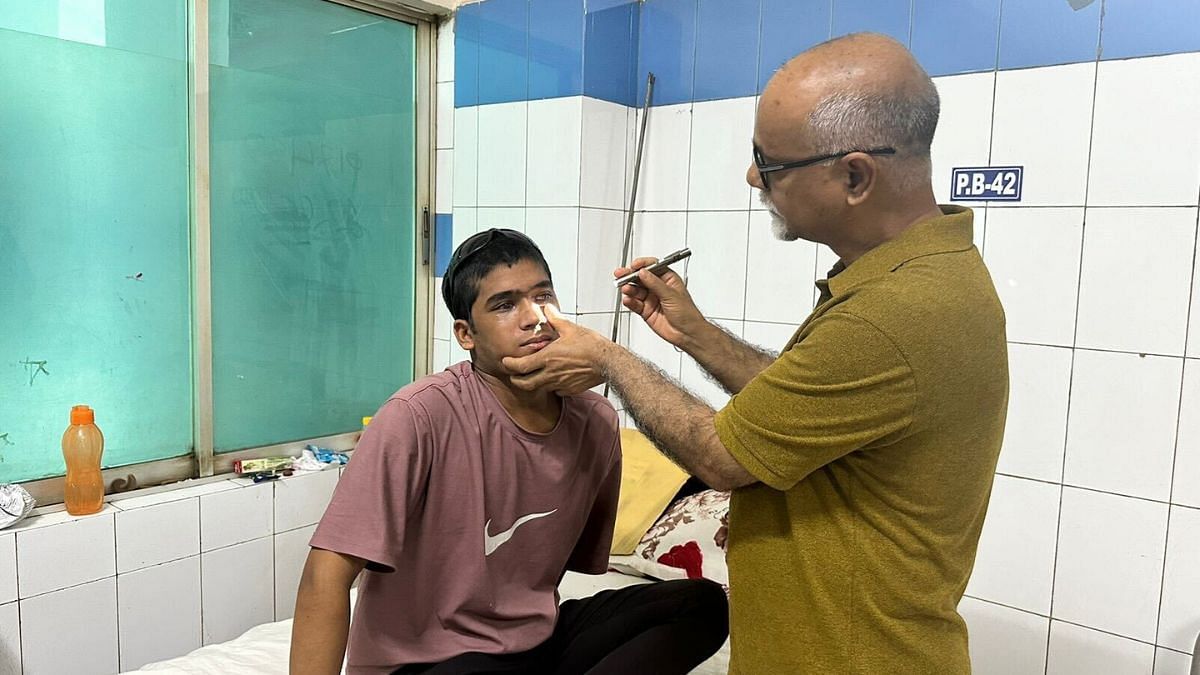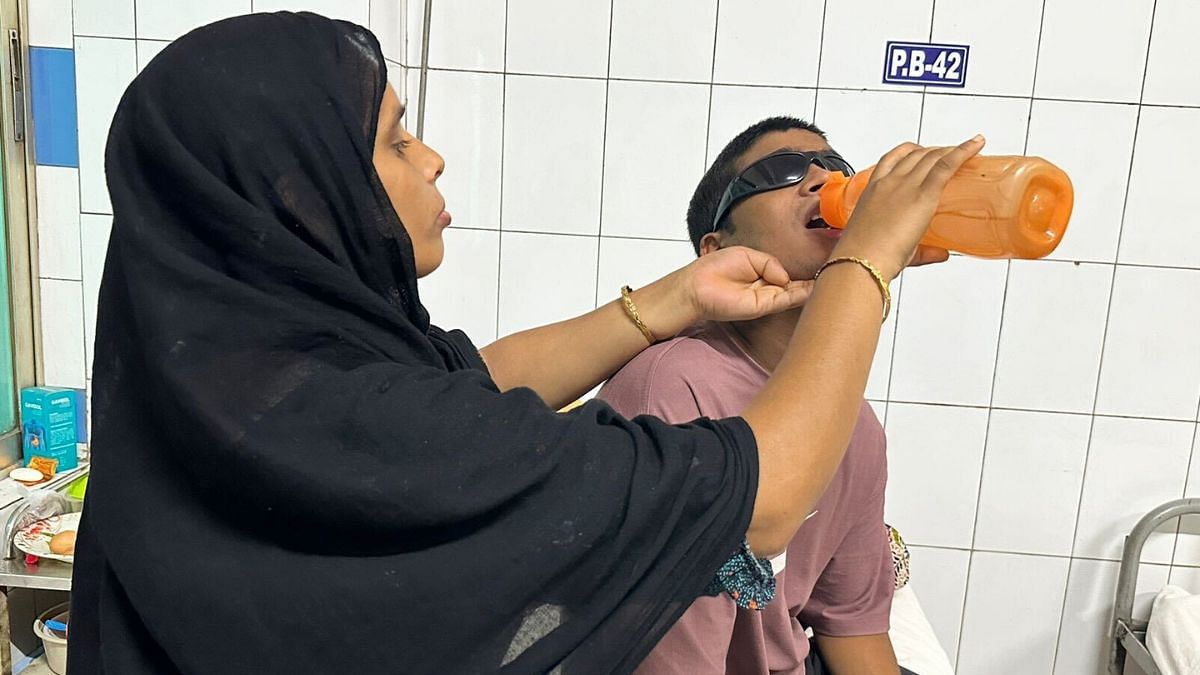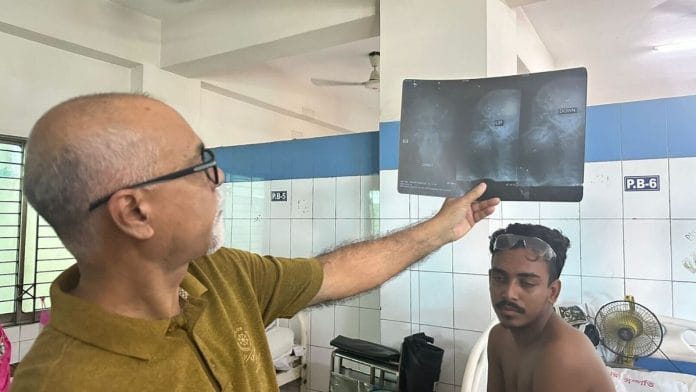Dhaka: Sitting on a hospital bed, Omar Farooq rubs his eyes. He tries to open them wide, then shuts them tightly. He puts on his spectacles and repeats the blinking motion.
Farooq’s mother, standing beside him, watches with a glimmer of hope. “Any progress? Can you see even a little?” she asks, visibly worried. The 20-year-old shakes his head. His mother pulls him into a hug as her eyes fill with tears.
A student in the electronics department at Bangladesh’s Bogura Polytechnic Institute, Farooq lost his vision in early August after being hit with pellets during the protests that ended former prime minister Sheikh Hasina’s 15-year rule.
On 4 August, security forces and police allegedly fired pellets at a group of students who were providing medical supplies and assistance to injured protesters outside the Ansar Headquarters in Dhaka, injuring dozens of them. Farooq was among them.
The incident occurred a day before lakhs of people stormed the prime minister’s official residence, vandalised public property, and set police stations afire as Hasina fled the country.
“The last thing I saw was a lot of armed personnel in gear in front of us and smoke everywhere from the tear gas they had lobbed at us,” Farooq says, recounting the day of the incident. “Then something pierced my eyes, face and chest. Within seven to ten seconds, I fell. I couldn’t see anything but I could hear students yelling for help.”
He alleged that while he was lying on the ground, screaming for help, he was hit by more pellets, this time from a close range. After this, he blacked out, only regaining consciousness at the hospital.
“It all happened so fast. Now the doctors tell me that even after surgeries, I will not be able to see. I am blind, I can never see a machine again, my career is over,” he says with a straight face.
Bangladesh security forces and police were accused of using lethal force during its crackdown on protesters. Human rights groups raised concerns over the use of live ammunition, rubber bullets and shotgun pellets, along with stun grenades and tear gas.
Speaking to ThePrint, Nahid Islam, information and communications tech adviser to the interim government, said that all these cases will be investigated thoroughly. “The ones who were injured, and the ones who were killed, we would ensure justice to all,” he said.
At the National Institute of Ophthalmology in Dhaka, Farooq is not alone in his suffering.
More than a thousand students were admitted with pellet injuries at the peak of the protests. A ward has been dedicated exclusively to these students. Of the thousand, more than 40 students have been completely blinded while over 500 were partially blinded, after pellets pierced their retinas and corneas, causing permanent eye damage.

The ward on the third floor of the hospital, where many students who still have pellets lodged in their brains, faces, or spines are being treated, is now commonly known as the “student protest ward”.
The young students—some aspiring to be electrical engineers and academicians, others surgeons or artists—are hoping against hope that they may one day regain their vision.
‘Horrific sight’
A similar story unfolds at another bed. Professor Mohammad Abdul Quader, a cornea expert and the doctor on duty, examines the x-ray of Onik Haldar, another 20-year-old student.
The x-ray of the skull shows over a hundred white spots where fragments of several pellets are lodged—some concentrated towards the eyes, others near the left temple, some in the neck and the rest on the top of the skull.
“These are all pellets that are lodged inside the head,” Quader says, pointing at the film.
Quader has treated hundreds of such cases in the weeks since the protests turned violent mid-July. “In some cases, pellets have damaged one eye, and in others, both eyes, causing blindness. Pellets are stuck in the entire skull. We have never seen such horrific cases.”
“At least repair one of his eyes,” cries Shetu Akhtar Sajida, Onik’s sister.
“My brother loved machines, he wanted to be an engineer. Now he is blind … I really pray that he is at least able to see from one eye. The doctors have said they are trying and will do one more surgery. He is totally dependent on me now, for his food, to go to the washroom, and this breaks my heart,” she adds.

Recalling the first few days when hundreds of such cases were reported to the hospital, Quader says, “In the first stage, on 18 July, there was a massive rush of patients. We were overwhelmed. On that day we operated on 66 patients, on the second day there were 62 operations.”
“The ten operations theatres at this hospital were full everyday with so many surgeries happening just to save the eyesight of these students somehow,” he recalls.
He adds that doctors at the hospital were forced to work for 72 hours with little to no sleep to attend to these cases. “It was horrific. Students with bleeding eyes. In just this hospital, 40 were bilateral blind (lost vision in both eyes), and over 500 lost vision in one eye.”
In most cases the injuries in the eyes were caused due to pellets, says Quader.
“While in some cases injuries in eyes were due to assault, 99 percent of the cases were that of pellets. We as doctors, who do so many surgeries on a daily basis, felt unsettled looking at these injuries. Terrible. So many lives spoilt, careers destroyed,” he adds.
Quader says that they are still trying to revive the eyesight of people by using whatever means available. “We are doing our best,” he says, before moving on to his next patient.
‘Happy to have contributed to movement’
For many students, just like Farooq, much rides on completing their education.
Farooq’s father, a farmer, left his fields and started driving a peddle rickshaw to raise money for his education, hoping that Farooq would become an engineer, secure a job, and support the family—that dream now appears shattered.
“My father came to Dhaka only so that he could collect money by pulling the rickshaw to get me admission to the (polytechnic) institute. After he found out that I had lost my vision, he was heartbroken. I was their hope, their window to a better life but not anymore,” he said.

But does Farooq regret being part of the protest because of which he lost his vision?
“No”, he says, adding that he may have gone blind, but the success of this protest which led to the ouster of Sheikh Hasina and the end of her autocratic regime gives him “immense satisfaction”.
“My career is over but now the next generation will have a bright future. I lost my eyes, but I played a part in the fall of an autocratic regime and that gives me happiness. My struggle did not go in vain, I contributed to this movement and made it a success,” he says.
Mohammad Habibh Sheikh, a 21-year-old who was in his second year of studying economics at Dhaka International University is thankful to be alive. He was at a protest on 5 August, the day Sheikh Hasina fled Bangladesh, when he was hit by pellets.
“So many of my friends died, others were blinded. I am lucky that I am alive and can still see with one eye. The retina of my other eyes is completely damaged and the doctors told me that the surgery could not remove the pellets lodged in the left eye,” he says.
For Mohamad Shariyatur Rahman, 23, a student at Bardim nursing college, Dhaka, 18 July was like a bad dream. He says whatever he witnessed would haunt him forever.
“A group of students were at a protest helping each other with essentials when the police showered pellets at us. We couldn’t understand what hit us. I felt something hit my head very hard and then the eye but I did not feel any pain. When I put my hand on my eye, it was bleeding and I could not see anything. Within minutes, I blacked out,” he says.
Rahman lost his vision in his left eye. “I am thankful to Allah that I only lost one eye. I will never be able to forget that moment. All my life,” he says.
(Edited by Sanya Mathur)







Just wishing that this is not some poetic justice signifying loss of “vision” for the nation. Release of convicted terrorists also shows the same. Did they oust Hasina or did they invite themselves to the den of the wolves ?